Upwards movement continued throughout this week as expected.
Summary: Assume the trend remains the same until proven otherwise. Assume more upwards movement to the next short-term target at 3,268.
If price makes a new low now below 3,220.51, then assume minor wave 4 has arrived. Minor wave 4 should last about two weeks or so and may end somewhere within the range of 3,154.26 to 3,070.49 (the upper edge of this range is preferred).
Thereafter, the next target is at 3,302 for a larger fourth wave correction and then 3,336 for an even larger fourth wave correction.
Three large pullbacks or consolidations (fourth waves) during the next 1-2 years are expected: for minor wave 4 (coming soon), then intermediate (4), and then primary 4. Some weakness prior to each of these corrections may be evident in technical analysis. Weakness is now evident in VIX, and conditions are becoming extreme. Extreme conditions warrant more careful attention to risk management at this time.
The biggest picture, Grand Super Cycle analysis, is here.
Monthly charts were last published here, with video here. There are two further alternate monthly charts here, with video here.
ELLIOTT WAVE COUNTS
The two weekly Elliott wave counts below will be labelled First and Second. They may be about of even probability. When the fifth wave currently unfolding on weekly charts may be complete, then these two wave counts will diverge on the severity of the expected following bear market. To see an illustration of this future divergence monthly charts should be viewed.
FIRST WAVE COUNT
WEEKLY CHART
The basic Elliott wave structure consists of a five wave structure up followed by a three wave structure down (for a bull market). This wave count sees the bull market beginning in March 2009 as an incomplete five wave impulse and now within the last fifth wave, which is labelled cycle wave V. This impulse is best viewed on monthly charts. The weekly chart focusses on the end of it.
Elliott wave is fractal. This fifth wave labelled cycle wave V may end a larger fifth wave labelled Super Cycle wave (V), which may end a larger first wave labelled Grand Super Cycle wave I.
The teal Elliott channel is drawn using Elliott’s first technique about the impulse of Super Cycle wave (V). Draw the first trend line from the end of cycle wave I (off to the left of the chart, the weekly candlestick beginning 30th November 2014) to the end of cycle wave III, then place a parallel copy on the end of cycle wave II. This channel perfectly shows where cycle wave IV ended at support. The strongest portion of cycle wave III, the end of primary wave 3, overshoots the upper edge of the channel. This is a typical look for a third wave and suggests the channel is drawn correctly and the way the impulse is counted is correct.
Within Super Cycle wave (V), cycle wave III is shorter than cycle wave I. A core Elliott wave rule states that a third wave may never be the shortest. For this rule to be met in this instance, cycle wave V may not be longer in length than cycle wave III. This limit is at 3,477.39.
Cycle wave V may subdivide either as an impulse or an ending diagonal. Impulses are much more common. An alternative wave count which considered an ending diagonal has been invalidated. While it is possible a diagonal may become an alternate wave count in coming weeks or months, at this stage the structure does not fit.
At this stage, cycle wave V may take another one to two or so years to complete.
The daily chart below will focus on movement from the end of intermediate wave (2) within primary wave 3.
In historic analysis, two further monthly charts have been published that do not have a limit to upwards movement and are more bullish than this wave count. Members are encouraged to consider those possibilities (links below summary) alongside the wave counts presented on a daily and weekly basis. It is my judgement that the two weekly wave counts published in this analysis have the highest probability, so they shall be the only wave counts published on a daily basis.
Within cycle wave V, primary waves 1 and 2 may be complete. Within primary wave 3, intermediate waves (1) and (2) may be complete. Within the middle of intermediate wave (3), no second wave correction may move beyond its start below 2,855.96.
DAILY CHART
All of primary wave 3, intermediate wave (3) and minor wave 3 may only subdivide as impulses.
Minor wave 3 has passed 1.618 the length of minor wave 1, and within it minute wave v has passed equality in length with minute wave i.
Today it is possible that minute wave v within minor wave 3 may be complete. However, the trend should be assumed to remain the same until proven otherwise. A new short-term target is calculated for minor wave 3.
Draw a small narrow channel about minute wave v within minor wave 3 as shown. While price remains within this channel, assume the upwards trend remains intact. If price breaks below the lower edge of this channel, then that may be an early warning that minor wave 4 may have arrived.
Within minute wave v, minuette wave (v) began at 3,220.51. A new low below this point could not be a second wave correction within minuette wave (v), so at that stage the last small upwards wave would have to be over and the probability that minor wave 3 may be over in its entirety would increase.
Minor wave 2 was a sharp deep pullback, so minor wave 4 may be expected to be a very shallow sideways consolidation to exhibit alternation. Minor wave 2 lasted 2 weeks. Minor wave 4 may be about the same duration, or it may be a longer lasting consolidation. Minor wave 4 may end within the price territory of the fourth wave of one lesser degree; minute wave iv has its range from 3,154.26 to 3,070.49.
Minor wave 4 may not move into minor wave 1 price territory below 3,021.99.
Intermediate wave (3) has now moved far enough above the end of intermediate wave (1) to allow intermediate wave (4) to unfold and remain above intermediate wave (1) price territory.
Draw an acceleration channel now about intermediate wave (3): draw the first trend line from the end of minor wave 1 to the last high, then place a parallel copy on the end of minor wave 2. Keep redrawing the channel as price continues higher. When minor wave 3 is complete, then this channel would be an Elliott channel and may show where minor wave 4 may find support if it is long lasting or deep enough.
HOURLY CHART
The hourly chart will now focus on minute wave v.
Always assume a trend remains the same until proven otherwise. At this stage, this market is in a clear upwards trend that is not yet extreme.
Within minute wave v, minuette waves (i) through to (iv) may now all be complete. Minuette wave (v) shows a small decline in momentum; this wave count still fits with MACD. Price remains within the best fit channel.
Minuette wave (v) must subdivide as a five wave structure, and within it subminuette wave ii may not move beyond the start of subminuette wave i below 3,220.51. A new low below this point would also necessitate a breach of the best fit channel, so a trend change would then be indicated.
If the degree of labelling within minuette wave (v) is moved up one degree, then it is possible that minor wave 3 may be a complete structure at all wave degrees.
SECOND WAVE COUNT
WEEKLY CHART
This weekly chart is almost identical to the first weekly chart, with the sole exception being the degree of labelling.
This weekly chart moves the degree of labelling for the impulse beginning in March 2009 all down one degree. This difference is best viewed on monthly charts.
The impulse is still viewed as nearing an end; a fifth wave is still seen as needing to complete higher. This wave count labels it primary wave 5. Primary wave 5 may still need another year to two or so to complete, depending upon how time consuming the corrections within it may be.
Primary wave 5 may be subdividing as an impulse, in the same way that cycle wave V is seen for the first weekly chart.
TECHNICAL ANALYSIS
MONTHLY CHART

Click chart to enlarge. Chart courtesy of StockCharts.com.
There are three large consolidations noted on this chart, in shaded areas. After a breakout from a multi-month consolidation, it is reasonable to expect a multi month bullish move may result.
Note that in each of the first two cases a pullback saw price re-enter the consolidation zone after the breakout, before price then moved up and away. It is possible that may happen again after the last breakout from a consolidation.
This chart very clearly exhibits rising price on declining volume has now persisted for several years. A decline in volume last month, in current market conditions, is not of concern.
On Balance Volume supports the Elliott wave count.
WEEKLY CHART
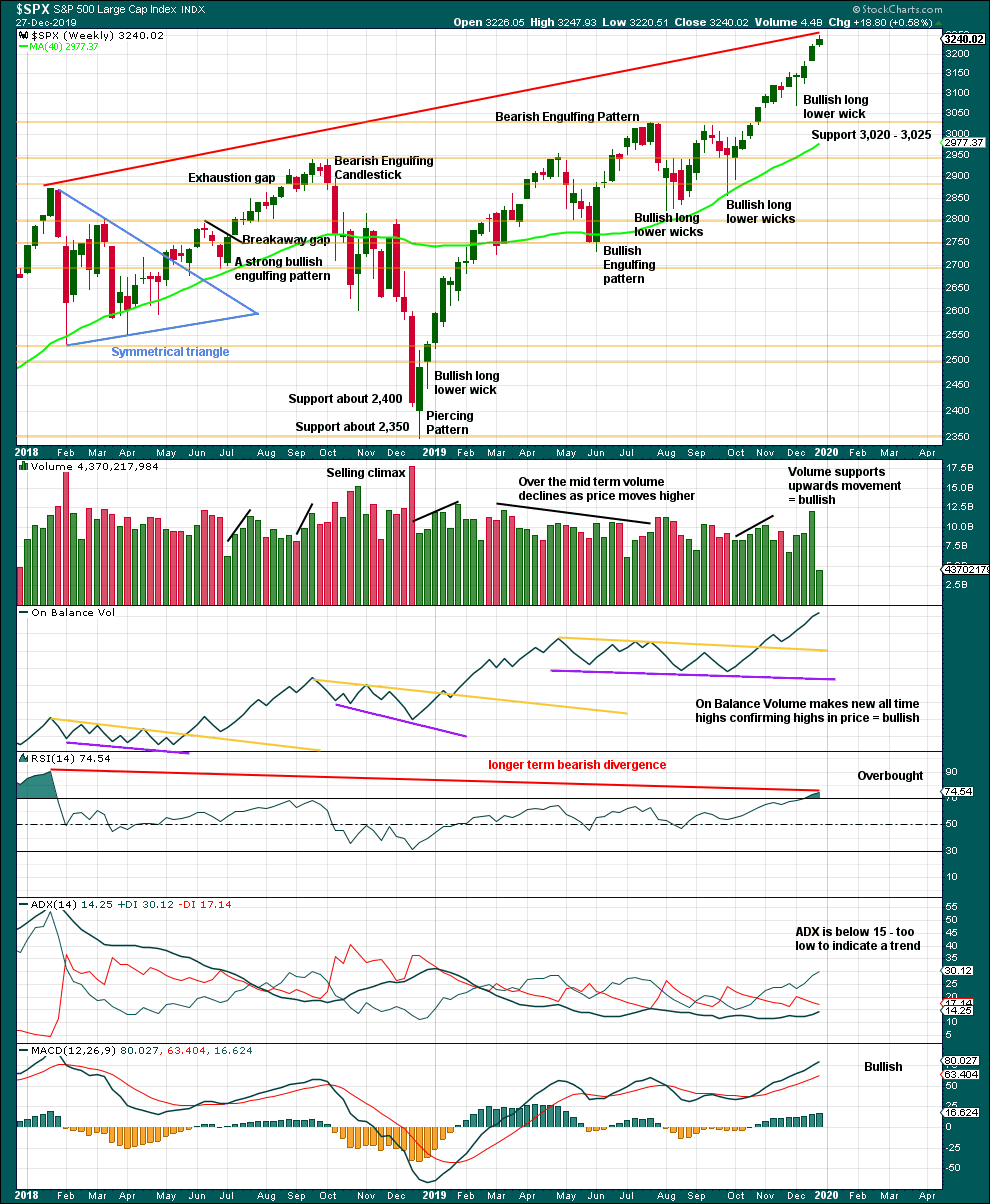
Click chart to enlarge. Chart courtesy of StockCharts.com.
It is very clear that the S&P is in an upwards trend and the bull market is continuing. Price does not move in straight lines; there will be pullbacks and consolidations along the way.
This chart is overall bullish. There are no signs of weakness in upwards movement.
RSI is now overbought. That does not mean upwards movement must end here, because it can continue for several weeks while RSI reaches more extreme. RSI reaching overbought is a warning that conditions are now becoming extreme. A pullback or consolidation will follow and the longer conditions are extreme the closer this will be. However, assume the trend remains the same until proven otherwise. This warning should be heeded by careful attention to risk management.
DAILY CHART
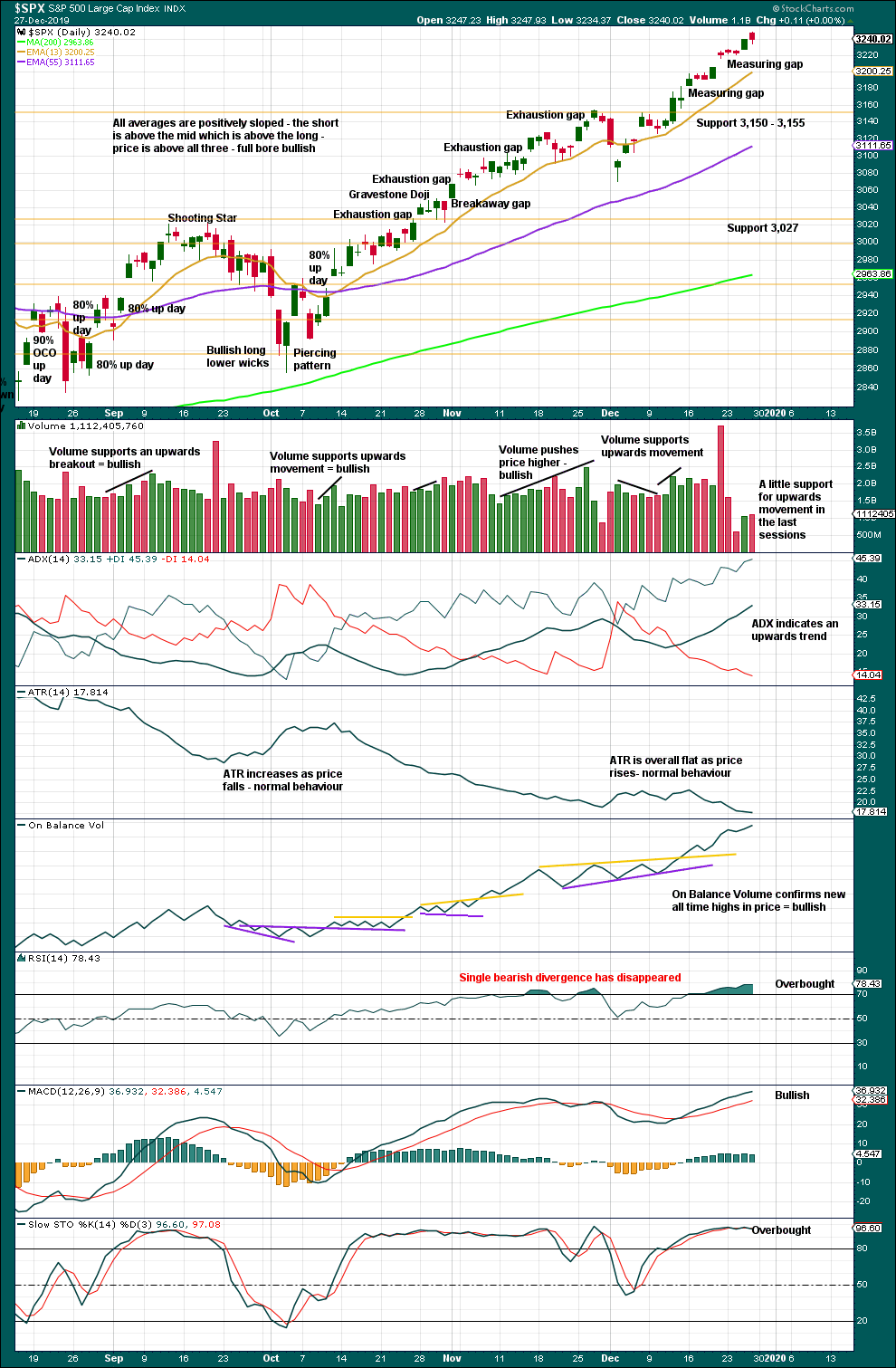
Click chart to enlarge. Chart courtesy of StockCharts.com.
There is an upwards trend in place. There will be corrections along the way.
Like the weekly chart, this chart is bullish.
With RSI overbought at both daily and weekly time frames, members are advised to pay careful attention to risk management. A larger pullback or consolidation will come to relieve extreme conditions. A bearish signal in the form of a candlestick reversal pattern, a 90% downwards day, strong bearish divergence in On Balance Volume or the AD line, or a combination of these signals, will be looked for. No bearish reversal signs are evident so far.
There is still room for this upwards trend to continue.
When this market trends, Stochastics may remain overbought for a very long time. Stochastics should be used to identify swings within a consolidation and not extremes of bull and bear trends.
This trend is not yet extreme. There is room for it to continue further. This market does not always give bearish signals just prior to an end to upwards trends. They can come along suddenly.
BREADTH – AD LINE
WEEKLY CHART

Click chart to enlarge. Chart courtesy of StockCharts.com. So that colour blind members are included, bearish signals
will be noted with blue and bullish signals with yellow.
Bear markets from the Great Depression and onwards have been preceded by an average minimum of 4 months divergence between price and the AD line with only two exceptions in 1946 and 1976. With the AD line making new all time highs last week, the end of this bull market and the start of a new bear market is very likely a minimum of 4 months away, which is mid March 2020.
In all bear markets in the last 90 years there is some positive correlation (0.6022) between the length of bearish divergence and the depth of the following bear market. No to little divergence is correlated with more shallow bear markets. Longer divergence is correlated with deeper bear markets.
If a bear market does develop here, it comes after no bearish divergence. It would therefore more likely be shallow.
All of small, mid and large caps have made new swing highs above the prior swing high on the 13th of September, and mid caps have now made new all time highs. This upwards movement appears to be mostly driven by large caps, which is a feature of aged bull markets. This bull market at over 10 years duration certainly fits the definition of aged.
Again both price and the AD line have made new all time highs. There is no divergence. Upwards movement has support from rising market breadth.
Large caps all time high: 3,247.93 on 27th December 2019.
Mid caps all time high: 2,069.95 on 20th December 2019.
Small caps all time high: 1,100.58 on 27th August 2018.
DAILY CHART

Click chart to enlarge. Chart courtesy of StockCharts.com. So that colour blind members are included, bearish signals
will be noted with blue and bullish signals with yellow.
Breadth should be read as a leading indicator.
On Friday price has moved higher, but the AD line has moved slightly lower. This divergence is a single day of bearish divergence. It may be a warning that minor wave 4 may have arrived, or it may result in no downwards movement.
VOLATILITY – INVERTED VIX CHART
WEEKLY CHART
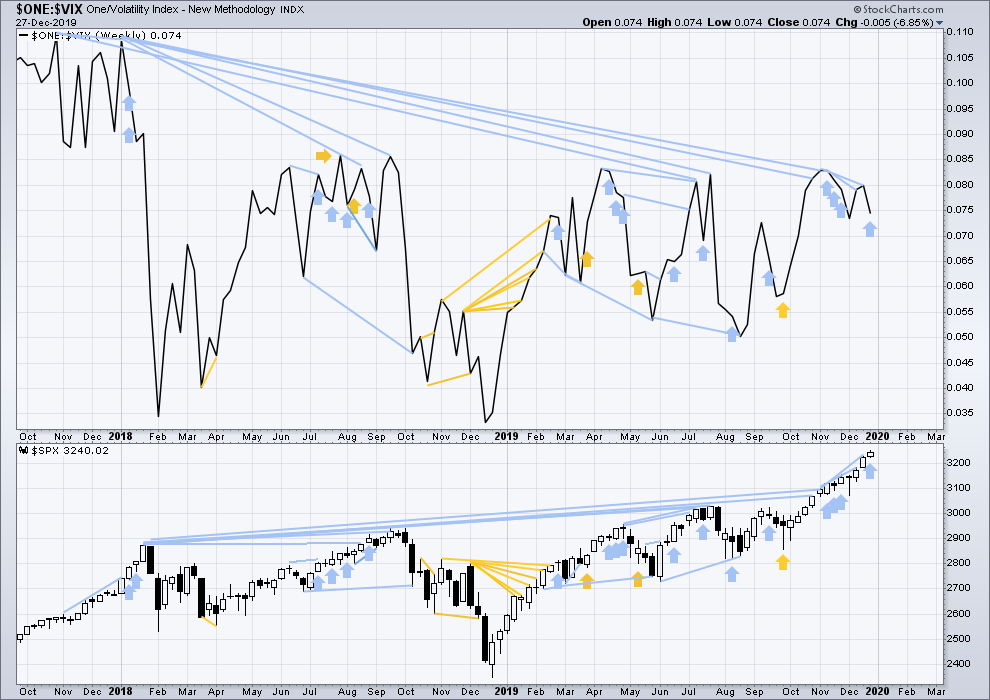
Click chart to enlarge. Chart courtesy of StockCharts.com. So that colour blind members are included, bearish signals
will be noted with blue and bullish signals with yellow.
The all time high for inverted VIX was on 30th October 2017. There is now over two years of bearish divergence between price and inverted VIX.
The rise in price is not coming with a normal corresponding decline in VIX; VIX remains elevated. This long-term divergence is bearish and may yet develop further as the bull market matures.
This divergence may be an early warning, a part of the process of a top developing that may take years. It may is clearly not useful in timing a trend change from bull to a fully fledged bear market.
This week price has moved higher, but inverted VIX has moved lower. This single week of bearish divergence may be a warning that minor wave 4 may have arrived, or it may yet develop further before minor wave 4 arrives.
DAILY CHART
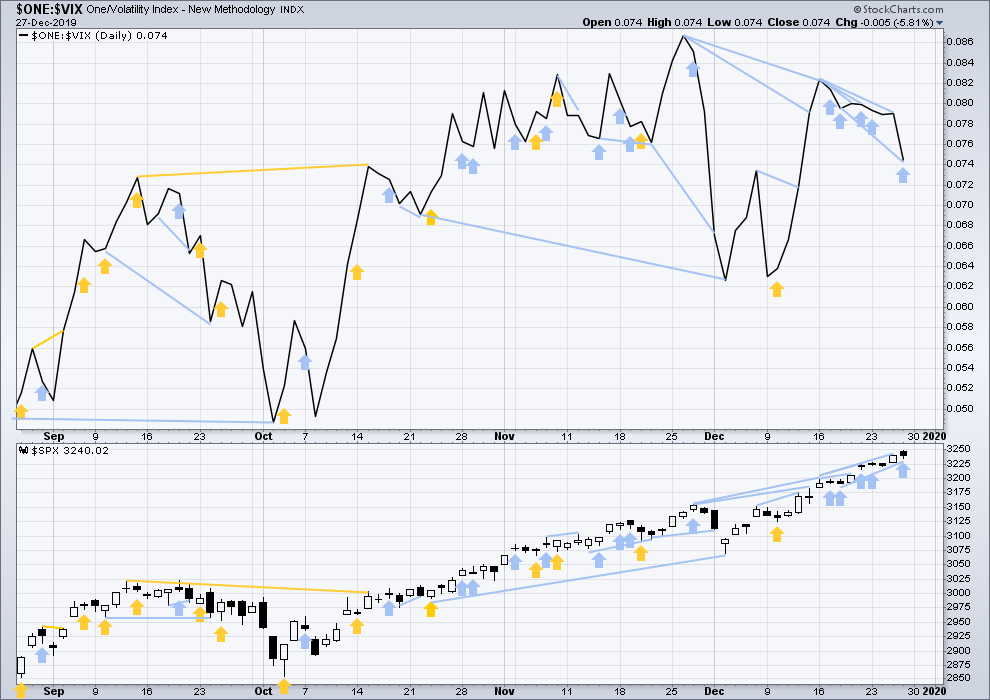
Click chart to enlarge. Chart courtesy of StockCharts.com. So that colour blind members are included, bearish signals
will be noted with blue and bullish signals with yellow.
On Friday price has moved higher, but inverted VIX has moved strong lower. Inverted VIX has made a new short-term low, but price has not. This divergence is bearish and may be a warning that minor wave 4 has arrived, or it may yet develop further before minor wave 4 arrives.
DOW THEORY
Dow Theory confirmed a bear market in December 2018. This does not necessarily mean a bear market at Grand Super Cycle degree though; Dow Theory makes no comment on Elliott wave counts. On the 25th of August 2015 Dow Theory also confirmed a bear market. The Elliott wave count sees that as part of cycle wave II. After Dow Theory confirmation of a bear market in August 2015, price went on to make new all time highs and the bull market continued.
DJIA: 23,344.52 – a close on the 19th of December at 23,284.97 confirms a bear market.
DJT: 9,806.79 – price has closed below this point on the 13th of December.
S&P500: 2,532.69 – a close on the 19th of December at 2,506.96 provides support to a bear market conclusion.
Nasdaq: 6,630.67 – a close on the 19th of December at 6,618.86 provides support to a bear market conclusion.
With all the indices having moved higher following a Dow Theory bear market confirmation, Dow Theory would confirm a bull market if the following highs are made:
DJIA: 26,951.81 – a close above this point has been made on the 3rd of July 2019.
DJT: 11,623.58 – to date DJT has failed to confirm an ongoing bull market.
S&P500: 2,940.91 – a close above this point was made on the 29th of April 2019.
Nasdaq: 8,133.30 – a close above this point was made on the 26th of April 2019.
Published @ 10:15 p.m. EST.
—
Careful risk management protects your trading account(s).
Follow my two Golden Rules:
1. Always trade with stops.
2. Risk only 1-5% of equity on any one trade.
—
New updates to this analysis are in bold.


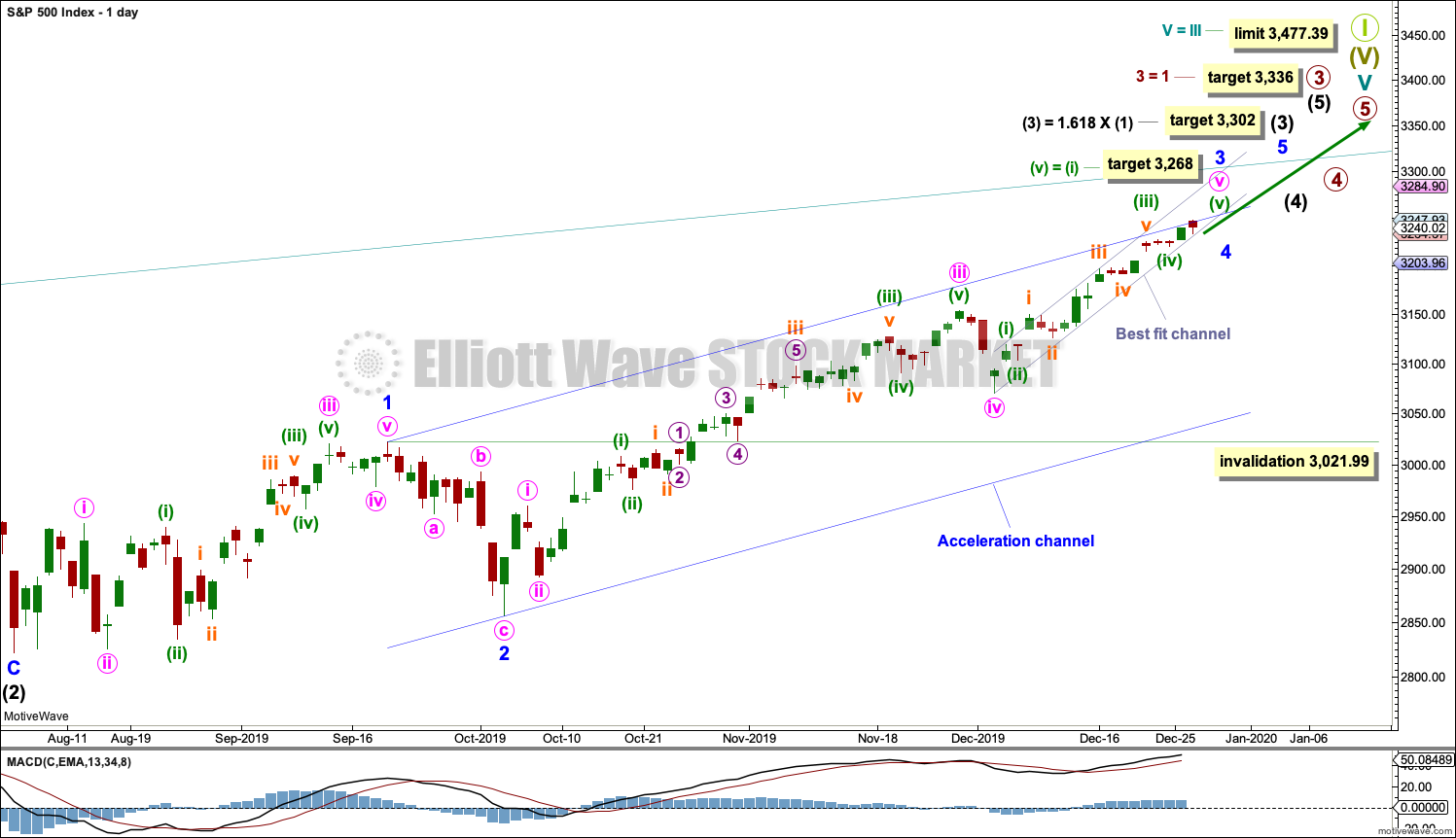
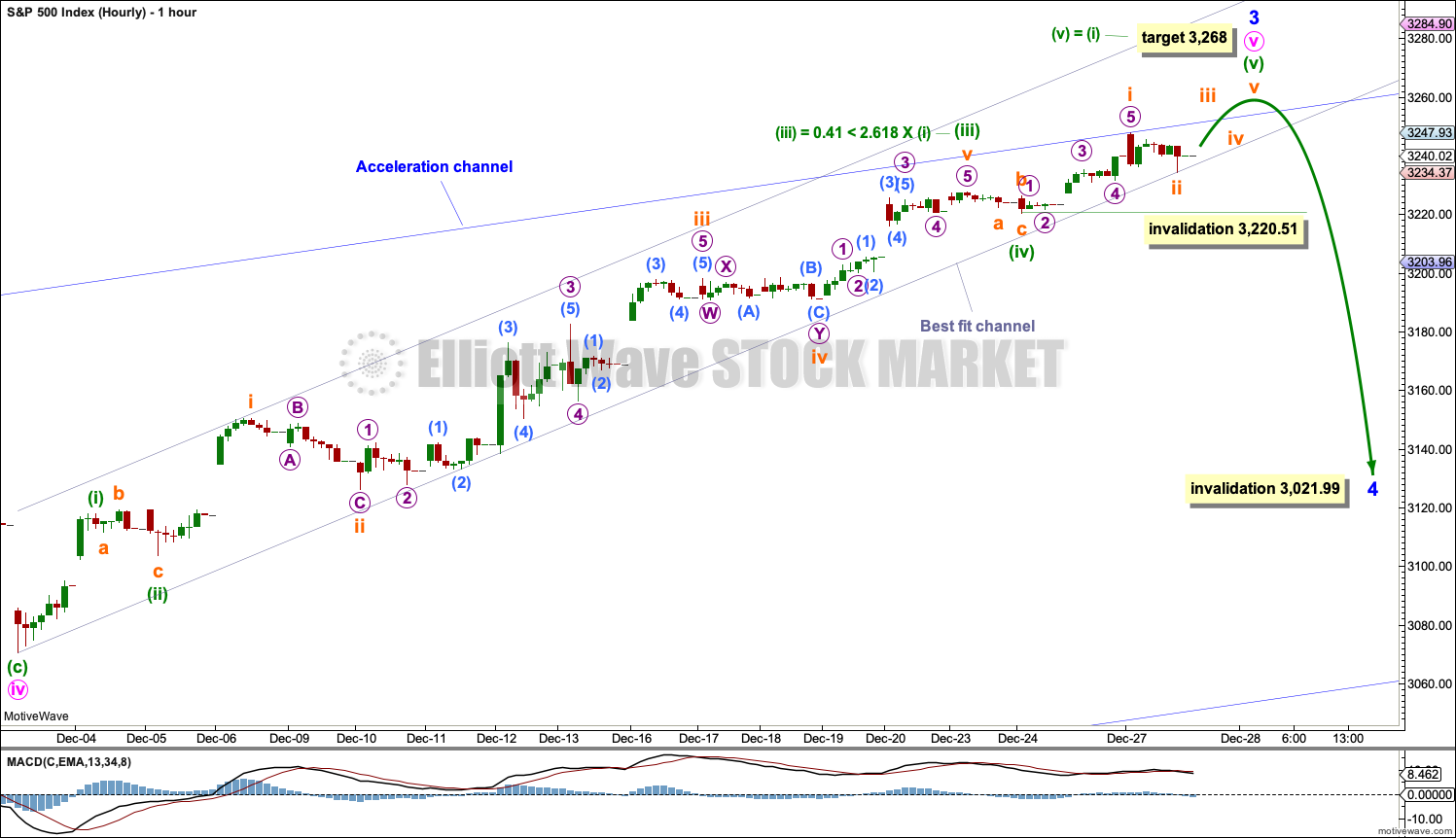
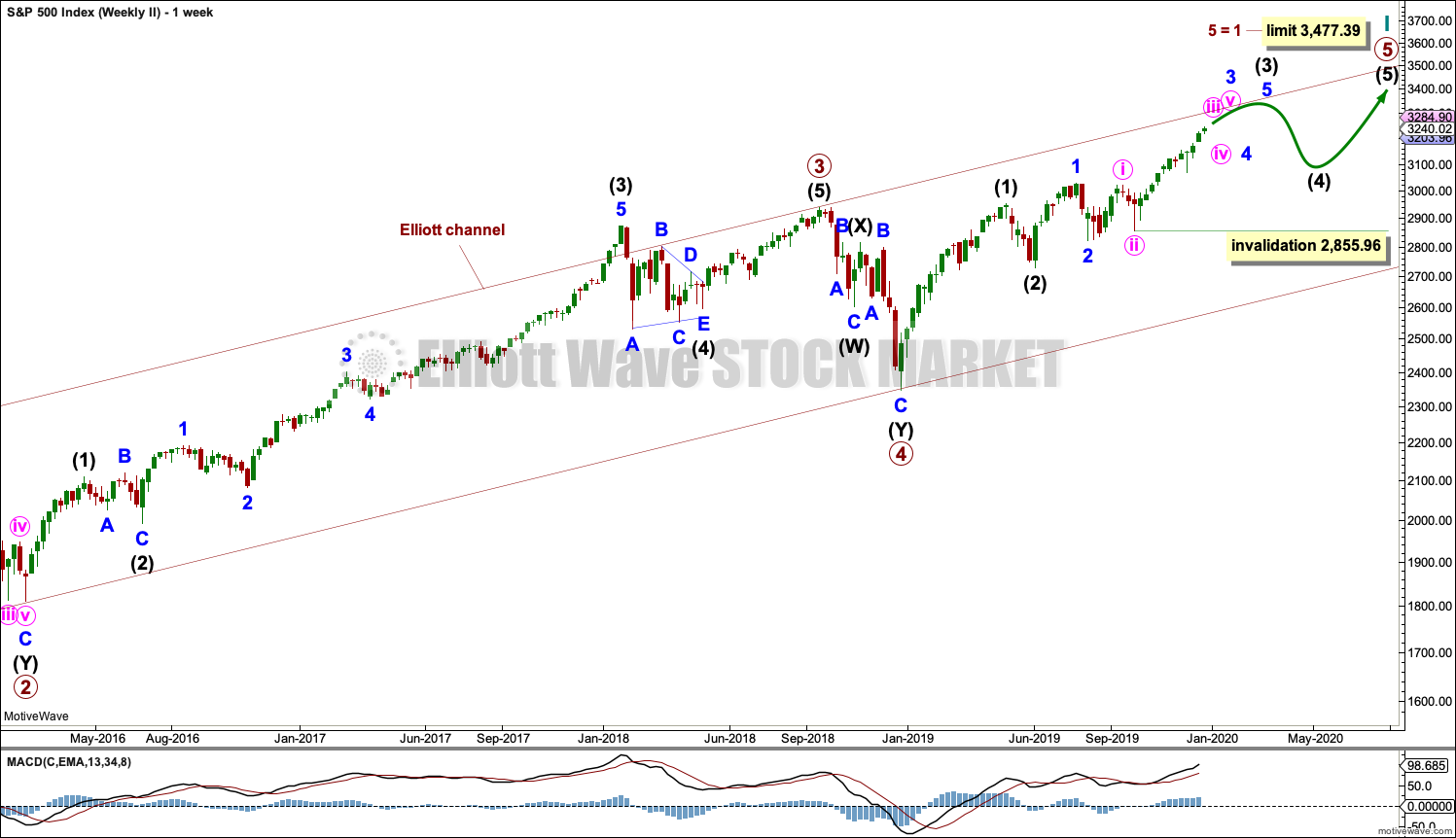
Hourly chart updated:
Because the small best fit channel is breached and 3,220.51 has been exceeded, I’m going to label minor 3 over and minor 4 begun.
The only Fibonacci ratio of minor 3 which sits in minute iv price territory is the 0.382 Fibonacci ratio, so that is the target now for minor 4. If this is wrong it may be too low.
Thanks Lara
I agree on the 38.2% target, possibly even lower to the 50%, now that would be great.
Start of minor 4????
Maaaaybe.
Put on AAPL and FB shorts 2 minutes into market, I think there’s real potential to the downside in both.
It’s hard to see how it could be anything else with 20 point move down today
I agree…but it’s not impossible it’s a another correction in an ongoing minor 3 up. Looking for more confirming evidence. Here’s the /ES view (2 hour bars, with overnight data) modeling the minor 3 as complete.
Hi everybody. I’ll be doing quite a lot of travelling in 2020, starting with a big road trip to surf in the South Island. I’m almost there, I’m in Wellington this morning. Christchurch next.
I’ve planned it so I’ll have adequate time to get work done, and there should be no interruptions at all nor anything published too late.
It’s amazing how beautiful this country is. We’ve had plenty of rain these last few months, and now at the beginning of summer the whole place is looking green and lush and just stunning.
Hello Lara,
Surfing, that sure sounds a great, yous have an excellent time.
I think that is great Lara. I hope you have fun surfing and traveling. Be safe as well.
5 pts eh???
Boy Oh Boy! You couldn’t wait to let an old man go first?
Hey, the 49r’s are my favorite to win the NFC and go to the Super Bowl. I think they will be playing the Baltimore Ravens which should make for a great game.
This one I think is worth 10 pts, as it’s the last one for 2019.
But we’re moving into a new decade. The next one… is 20 pts.
I make the rules. Because.
Whatever you say madam.
Hey now…10 pts! It’s my lucky day!!!!
Yes Rodney the 49er’s are FOR REAL. Now I noticed you favor them to GO TO the SB…not enough Sir, not enough!!! They are going to BEAT THE RAVENS. Do remember their last conflict: decided in what, the final play of the game? And the 49’ers had some key players out in that game too. 49’ers to WIN the SB!!! Note: FIVE STRAIGHT 49’er GAMES decided in the FINAL PLAY of the game as time expires. Absolutely crazy, been watching (or listening on the radio back in the 60’s) to football a long time, never seen anything like it.